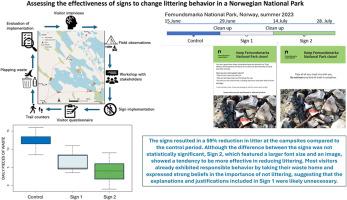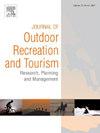Assessing the effectiveness of signs to change littering behavior in a Norwegian national park
IF 4.4
3区 管理学
Q1 HOSPITALITY, LEISURE, SPORT & TOURISM
Journal of Outdoor Recreation and Tourism-Research Planning and Management
Pub Date : 2025-08-05
DOI:10.1016/j.jort.2025.100930
引用次数: 0
Abstract
Littering in natural areas disrupts ecosystems and diminishes visitor experiences, posing a persistent challenge. This study explored how communication through signage could effectively reduce littering behavior. We tested two signage interventions at six campsites near Røvoltjønnan Lake in Femundsmarka National Park, Norway, using insights from visitor interviews and observations structured by the COM-B and the elaboration-likelihood models. Field experiments conducted in summer 2023 measured effectiveness through waste mapping, visitor surveys, and trail counters. Daily litter at the campsites ranged from 0 to 16 pieces, with an average of 13 pieces during the control period. Treatment period 1 (Sign 1), reduced this to 7 pieces, and treatment period 2 (Sign 2) to 4 pieces. Overall, there was a 59 % reduction in litter at campsites when the signs were implemented compared to the control period. While Sign 2, with larger font size and image, appeared more effective in reducing littering, the difference between the signs was not statistically significant, likely due to limited sample size. Most visitors already exhibited responsible behavior by taking their waste home and expressing a strong belief in the importance of not littering, suggesting that explanations and justifications included in Sign 1 were unnecessary. The signs likely served as reminders, increasing attentiveness and encouraging visitors to take all their waste with them, with some picking up litter left by others. These findings highlight the importance of targeted communication in fostering stewardship and providing actionable insights for park managers to reduce environmental impacts and promote sustainable visitor behavior.

评估挪威国家公园中改变乱扔垃圾行为的标志的有效性
在自然区域乱扔垃圾会破坏生态系统,减少游客体验,这是一个持续的挑战。本研究探讨了如何通过标识沟通来有效减少乱扔垃圾的行为。我们在挪威Femundsmarka国家公园r ø volj ønnan湖附近的六个露营地测试了两种标识干预措施,使用了来自游客访谈和COM-B结构观察的见解以及详细可能性模型。2023年夏季进行的实地实验通过废物测绘、游客调查和跟踪计数器来衡量有效性。营地每天的垃圾从0块到16块不等,在对照期间平均为13块。治疗期1(签名1),减少到7片,治疗期2(签名2)减少到4片。总体而言,与控制期相比,在实施这些标志时,露营地的垃圾减少了59%。虽然标志2的字体和图像更大,在减少乱扔垃圾方面似乎更有效,但两种标志之间的差异在统计上并不显著,可能是由于样本量有限。大多数游客已经表现出负责任的行为,他们把垃圾带回家,并表达了不乱扔垃圾的强烈信念,这表明标语1中的解释和理由是不必要的。这些标志可能起到了提醒的作用,增加了人们的注意力,并鼓励游客带走所有的垃圾,有些人还会捡起别人留下的垃圾。这些发现强调了有针对性的沟通在促进管理和为公园管理者提供可操作的见解方面的重要性,以减少对环境的影响,促进可持续的游客行为。
本文章由计算机程序翻译,如有差异,请以英文原文为准。
求助全文
约1分钟内获得全文
求助全文
来源期刊

Journal of Outdoor Recreation and Tourism-Research Planning and Management
HOSPITALITY, LEISURE, SPORT & TOURISM-
CiteScore
6.70
自引率
5.30%
发文量
84
期刊介绍:
Journal of Outdoor Recreation and Tourism offers a dedicated outlet for research relevant to social sciences and natural resources. The journal publishes peer reviewed original research on all aspects of outdoor recreation planning and management, covering the entire spectrum of settings from wilderness to urban outdoor recreation opportunities. It also focuses on new products and findings in nature based tourism and park management. JORT is an interdisciplinary and transdisciplinary journal, articles may focus on any aspect of theory, method, or concept of outdoor recreation research, planning or management, and interdisciplinary work is especially welcome, and may be of a theoretical and/or a case study nature. Depending on the topic of investigation, articles may be positioned within one academic discipline, or draw from several disciplines in an integrative manner, with overarching relevance to social sciences and natural resources. JORT is international in scope and attracts scholars from all reaches of the world to facilitate the exchange of ideas. As such, the journal enhances understanding of scientific knowledge, empirical results, and practitioners'' needs. Therefore in JORT each article is accompanied by an executive summary, written by the editors or authors, highlighting the planning and management relevant aspects of the article.
 求助内容:
求助内容: 应助结果提醒方式:
应助结果提醒方式:


